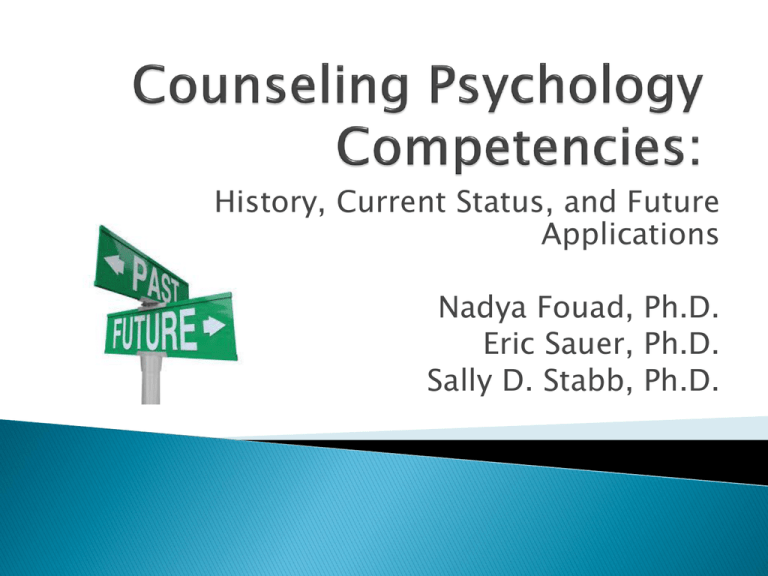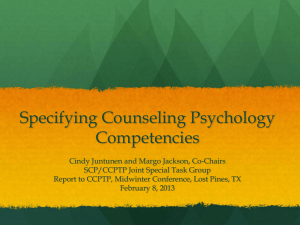History, Current Status, and Future Applications
advertisement

History, Current Status, and Future Applications Nadya Fouad, Ph.D. Eric Sauer, Ph.D. Sally D. Stabb, Ph.D. Sally D. Stabb, Ph.D. Texas Woman’s University Competencies movement has an approximately 25-year history Late 1980s – mid 90s: Initial writings 1996: CoA guidelines revised with increased attention to professional competency vs. curriculum 2002: Competencies Conference (APPIC, APA) 2005: Volume 36(4) of Professional Psychology: Research & Practice series of articles on competencies ◦ Perhaps the most influential of these was Rodolfa et al.’s “A Cube Model for Competency Development” ◦ Foundational and Functional Competencies integrated with a developmental perspective The Council of Chairs of Training Councils (CCTC) and the APA Board of Educational Affairs’ (BEA) expanded efforts over the next 4 years resulted in the creation of the Benchmark Competencies in 2009 (Fouad et al.) and the Competencies Assessment Toolkit (Kaslow et al.) Benchmark Competencies revised into a simplified cluster structure in 2011-12 (APA). An explosion of activities related to professional competencies in a range of areas has occurred (e.g. 108 articles published with this term in the title 2006-2014 in APA journals alone). Other areas in professional psychology already have their own competencies. o Clinical health psychology (France, et al., 2008) o Geropsychology (Knight, et al., o Clinical neuropsychology (Hannay,e t al, 1998), o Rehabilitation psychology (Stiers, et al, 2012), o School psychology (Daly, Dahl, Schulte, & Fenning, 2011). In 2012, a joint task force between SCP and CCPTP was created to develop competencies for Counseling Psychology In 2013, Counseling Psychology Competencies presented at CCPTP midwinter meeting, and consequently posted for two rounds of public comment July 2013: SCP approves the Counseling Psychology Competencies November 2013: CCPTP membership endorses the Counseling Psychology Competencies by majority vote Detailed descriptions of the STG timeline, composition, tasks and actions is available in the Counseling Psychology Competencies Rationale, which was distributed in fall of 2013 and is now on the CCPTP website under “Resources.” Eric M Sauer Western Michigan University A world class psychotherapy researcher said: “don’t throw the baby in the bath water.” We had to let him know that this idiom got lost in translation and we described the origin of this expression. A pile of broken ideas? Strong and daunting? It’s pretty good but doesn’t fit us… The Call: SCP and CCPTP Created a new STG to examine the Competencies Benchmarks in Processional Psychology Goal: identify whether there are specific CoPSY competencies that could or should be delineated, and, if so initiate the development of those competencies to provide information and guidance to CP doctoral programs. Team: included members from both SCP, CCPTP, and SAS (across the career lifespan) Process: Conference calls, readings, face-toface meetings. Core Question: do you think CoPsy competencies are adequately address in the existing competencies? Answer: nope! Not so much. Cindy Juntunen Co-chair Margo Jackson Co-chair Mary Ann Covey Nadya Fouad Eric Sauer Sally Stabb Femina Varghese Emily Voelkel-student representative 1. Foundational Competencies 2. Functional Competencies 3. Organizational Competencies Ready for Practicum Ready for Internship Ready to enter Practice Clinical health (France, et al., 2008), professional Geropsychology (Knight, Karel, Hinrichsen, Qualls & Duffy, 2009) Clinical neuropsychology (Hannay,e t al, 1998), Rehabilitation psychology (Stiers, et al, 2012), School psychology (Daly, Dahl, Schulte, & Fenning, 2011). 1. Really, nothing much was really deleted…it was more about adding, enhancing, or tailoring. 2. Some sections were overhauled, some sections tweaked, and some were left mostly as is. 3. Consistently added CoPsy relevant behavioral anchors and examples. Our STG identified three areas of particular importance to counseling psychology that were not represented in any existing competency documents: social justice, prevention, and vocational psychology (and there were others as well). Small, Medium and Large 1. “Professional Identity” changed to Demonstrates understanding of self as a counseling psychologist; considers contextual influences in practice, science, teaching, supervision and other roles; committed to holistic strength-based development through preventive, vocational, and social justice approaches. 1a. Core Professional Identity 1b. Holistic and Contextual Worldview 1c. Developmental, Strength-Based Focus 1d. Recognizes Value of Prevention 1e. Integrates Vocational Approaches 1f. Oriented towards Social Justice Only minor tweaks to behavioral anchor examples related to seeking out and integrating feedback, self-reflective practice, attending to nonverbal, awareness of oppression Added: Counseling Psychology Model Training Diversity Statement (Mintz & Bieschke, 2009). Added Anchors: Independently monitors and applies knowledge, skills, and attitudes of diversity dimensions regarding others as cultural beings in assessment, treatment/intervention, and consultation. No major changes Minor changes related to related to monitoring own problems and motivated for lifelong learning and development Added: Demonstrates an understanding of research as a potentially emancipatory tool, process [recognize the power of research to facilitate power and privilege] Demonstrates openness to multiple forms of scientific inquiry Added example: Identifies key documents/policies that guide the implementation of counseling psychology emphases in vocational psychology, social justice, and prevention. Added examples about CPs being agents of change and recognizing oppression at many levels. Added to definition that we integrate research and clinical expertise in the context of client factors Lots of changes to Anchors and Examples related to science-practice integration. For example, demonstrates basic knowledge of scientific, theoretical, and contextual bases of psychological assessment and intervention Or, effectively integrates knowledge of evidencebased practice, including empirical bases of assessment and intervention, clinical expertise, and client preferences Added section 10e: Supervisory Relationship ◦ Added BAs -Openness to feedback and willingness to engage in supervision. ◦ Added BAs-Demonstrates effective supervisory relationships and working alliances with other students and peers. ◦ Added BAs -Establishes relationships with supervisees that foster supervisee development ◦ Also added many CP examples of effective supervisory relationships. Changed 11d from “Diagnosis” to “Assessment/Diagnosis in Sociocultural Context.” Changed many associated examples. No substantive changes BA changes: Able to identify and monitor power differential with students to avoid exploitation BA Changes: Able to recognize privilege that come with power differential when serving as a teaching assistant or instructor Changes in final sections (14. Interdisciplinary Systems, 15. Consolation and 16. Management/Administration) Only minor tweaks related to demonstrating effectiveness in working with other professions or inter-professionalism. CP Competencies approved by SCP and CCPTP How can they be implemented? Nadya A Fouad University of Wisconsin-Milwaukee Rationale Competency Based Education Overview How to move to CBE What does high CBE look like? What are the implications? Consider the most time-consuming student situation you have ever had. How could you have prevented it? If the student graduated, do you have confidence s/he is a competent psychologist? How do we know someone is a competent counseling psychologist? How is the curriculum is organized for acquisition of all required competencies? How are competencies assessed and student progress tracked? How are assessment outcomes used to review and improve the curriculum? How does the program structure accommodate an individual student’s trajectory of developing competence? Decide which of the clusters are areas of focus in your own training program. For example, a program may want to focus on developing competencies in professionalism, relational, science and applications, but not in systems. Choose clusters, or parts of clusters that are consistent with your program goals and mission Within each cluster, select the essential competency components that you want students to develop. Each essential component is rated using a frequency scale (e.g., “sometimes,” “almost always”) to determine characteristic desired of trainees For example, a strong emphasis on multicultural counseling, choose two essential components (2A, 2B) of ICD for the first two years of training, and expect the behavior to be often characteristic Rate items below using the following frequency scale Never/Rar Sometime ely s 0 1 : Often 2 Almost Always 3 Always 4 Refer to the Appendix and select/modify examples relevant to your program that help to clarify essential components Inclusive, setting-wide effort to identify and define the setting’s competence goals Examine curriculum for how to help students gain competencies Develop ratings of competence progress across multiple training experiences to track student progress Inform choices and goals of further training experiences. CBE is student centered, rather than course or teacher centered. Students demonstrate competencies. Implications for time Focus on the student’s development Issues for us in universities geared around semesters and tuition credits Systematic tracking—online possibility Will CoA look for all three areas (social justice, vocational psychology, prevention) to be called a counseling psych program? How do these link to the benchmarks? We already do those, do we have to change? APA (2011). Reviewed Competency Benchmarks in Professional Psychology. Retrieved from http://www.apa.org/ed/graduate/benchmarks-evaluationsystem.aspx APA (2012, May). Benchmarks clusters and core competencies, revised. Retrieved from http://www.apa.org/ed/graduate/benchmarks-clusters-competencies.pdf Daly, E. J., Doll, B., Schulte, A. C. & Fenning, P. (2011). The competencies initiative in American professional psychology: Implications for school psychology preparation. Psychology in the Schools, 48, 872–886. doi: 10.1002/pits.20603 Fouad, N. A., Grus, C. L., Hatcher, R. L., Kaslow, N. J., Hutchings, P., Madson, M. B., & ... Crossman, R. E. (2009). Competency benchmarks: A model for understanding and measuring competence in professional psychology across training levels. Training And Education In Professional Psychology, 3(4, Suppl), S5-S26. doi:10.1037/a0015832 France, C.R., Masters, K. S., Belar, C. D.; Kerns, R. D., Klonoff, E. A….& Thorn, B. E. (2008). Application of the competency model to clinical health psychology. Professional Psychology: Research and Practice, 39, 573-580. doi: 10.1037/07357028.39.6.573 Hannay, H. J., Bieliauskas, L. A., Crosson, B. Hammeke, Hamsher, K. deS., & Koffler, S. (1998). Proceedings of the Houston Conference on Specialty Education and Training in Clinical Neuropsychology. Archives of Clinical Neuropsychology, Special Issue,13, 2. Kaslow, N. J., Grus, C. L., Campbell, L. F., Fouad, N. A., Hatcher, R. L., & Rodolfa, E. R. (2009). Competency Assessment Toolkit for professional psychology. Training And Education In Professional Psychology, 3(4, Suppl), S27-S45. doi:10.1037/a0015833 Knight, B. G.; Karel, M. J.; Hinrichsen, G. A.; Qualls, S. H., & Duffy, M. (2009). Pikes Peak model for training in professional geropsychology. American Psychologist, 64, 205-214. doi: 10.1037/a0015059 Mintz, L. B. & Bieschke, K. J. (2009). Counseling psychology model training values statement addressing diversity: Development and introduction to the major contribution. The Counseling Psychologist, 37, 634-640. doi: 10.1177/0011000009331923 Rodolfa, E,; Bent, R,; Eisman, E.; Nelson, P.; Rehm, L., & Ritchie, P. (2005). A cube model for competency development: Implications for psychology educators and regulators. Professional Psychology: Research and Practice, 36, 347-354. doi: 10.1037/0735-7028.36.4.347 Stiers, W., Hanson, S., Turner, A. P., Stucky, K.; Barisa, M. …& Kuemmel, A. (2012). Guidelines for postdoctoral training in rehabilitation psychology. Rehabilitation Psychology, 57, 267-279. doi: 10.1037/a0030774








